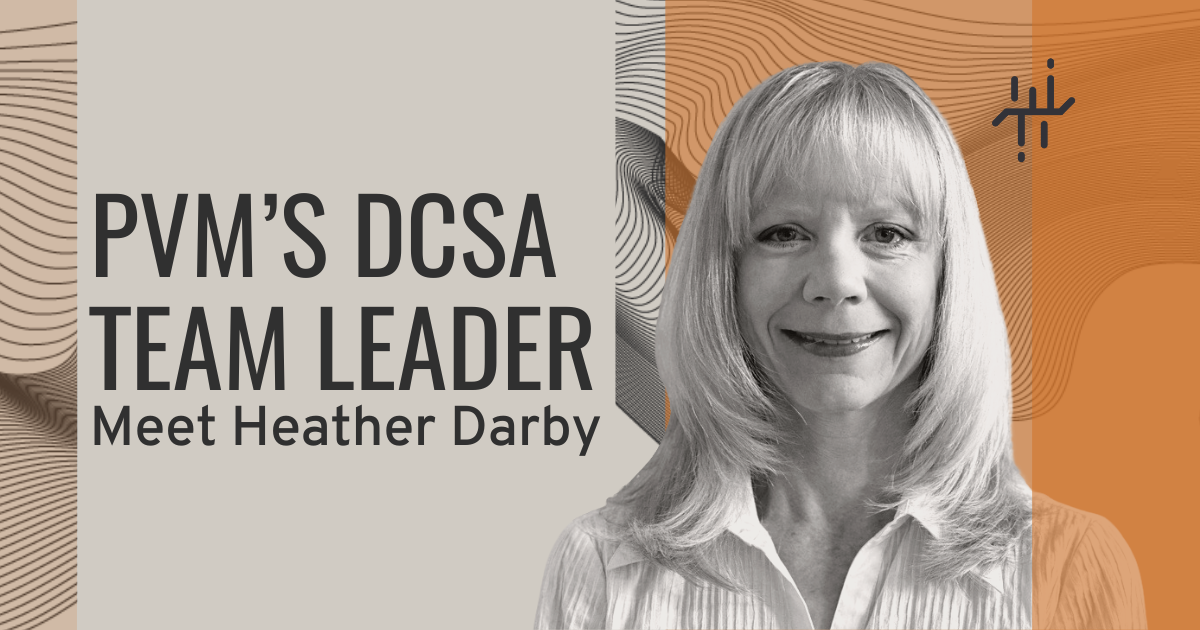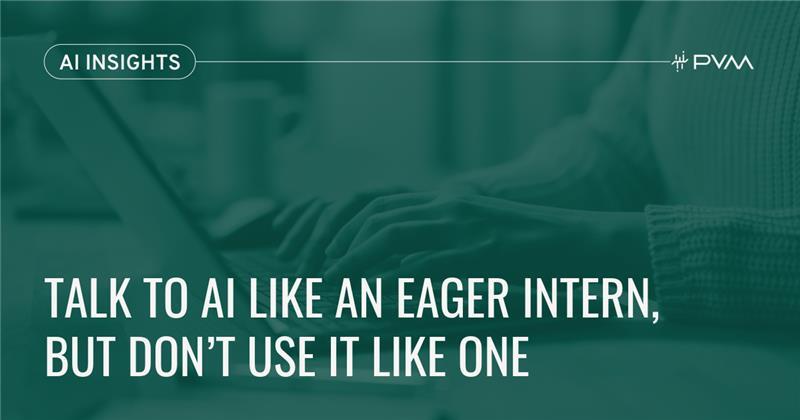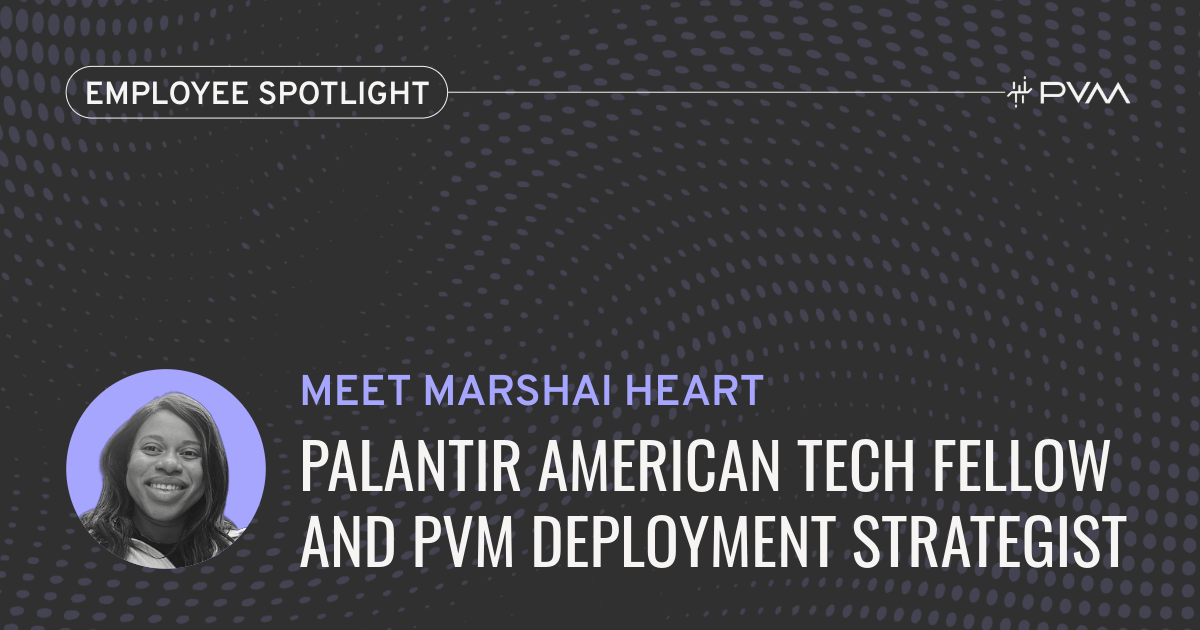A Marine’s Lesson in Innovation — From a Freezing Cold Field Mission in Korea to Today
By Bret Frederick When I was a young Marine, I worked as a systems administrator on the Marine Corp’s air battle planning system. It was part of a...
I NEED HELP WITH...
I'M WORKING WITH...
INDUSTRIES

At PVM, we have extensive experience unlocking the power of data and helping our clients achieve their missions in federal, state, and local governments, as well as commercial sectors. In today's data-driven world, organizations across all sectors recognize that their success hinges on harnessing the full potential of their data.

ABOUT US

3 min read
![]() The PVM Team
February 27, 2023
The PVM Team
February 27, 2023

Heather Darby is a former PVM employee.
--
Over the past 6 years, PVM has partnered with the Defense Counterintelligence and Security Agency to help support their data systems. We sat down with Account Manager Heather Darby to learn more about how PVM helps DCSA accomplish their mission.
I went to George Mason University and received my electrical engineering degree. Then I went on to Case Western Reserve University and received my master’s degree in electrical engineering. After graduating with my master's degree, I realized I didn’t want to do the design and development role as an engineer. I have a love for people and customer service. Twenty years ago, I was introduced to project management. Project management is the link between interacting with your customer, helping your customer achieve their goals, supporting their mission, and having a technical team to back all of that up. From there, my career in program management progressed. Then, I got married and my husband and I went into our own business with about 200 employees. I was on the sales and financial end of it until we closed in 2015. This allowed me to get my foot back in the door into program management and shortly after, I began my current role with PVM as an Account Manager. I am so grateful to have found this position because it is exactly what I love doing.
On my team, we are always focused on working closely with the client to help them solve their challenges. Whenever we come across an issue, my first step is always to connect with the appropriate individual, figure out what their challenge is, and set up a meeting with them. This face time with the client helps build a trusting relationship and shows that I am listening to them and hearing what the problem is. Second, my Tech Lead, David Payne, is brought in to understand customer’s problem on a deeper level. Finally, my team gets together to determine what steps need to be taken to fix the problem whether it’s a new release, patch fix, or if it’s a bug that can be fixed at all.
The key is communication. When we come to some type of resolution, we communicate to the customer what we're doing to solve the problem, so they stay in the loop and know we haven’t put their concerns aside.
They are proactive. There are so many technical issues that they must deal with, so they are in constant education mode in order to deliver the best for our client. It's not necessarily that they sign up for a Java class or they sign up for this class or that class, but they just they must keep it up with it on an ongoing basis.
The engineers also all come from different backgrounds and have worked on different projects, so they often work together to solve challenges.
My team’s Tech Lead, David Payne, also provides support to the engineers. As he sees a need to set up one-on-ones with my team members, he does that. For example, if he has a Junior Software Developer that really needs to get this task done, he will meet with them on an ongoing basis until they’re ready to fly on their own.
I think listening is one of the most important ways we can keep our customers’ needs and requirements at the forefront. One way I approach this is by holding a stand-up sync meeting with the client to discuss, for example, any new approval documents that we submit to them for questions. Essentially, on an ongoing basis, I have that weekly meeting to make sure I am aware of any new requests or questions they have. So again, it's communication. We make sure we make the time to listen to the client and understand their needs. It has worked very well! The key is meeting and communicating as much as possible, not just over e-mail, but also face-to-face, whether that’s in-person or over a video call.
We recently took a trip to meet the client on-site. One of the main purposes of that visit was to understand how we were going to develop the project with the next software release in a way that represented our collective mission to the fullest and helped the client solve the challenges they were facing day to day. With that upcoming release not having a clear path, we met face-to-face with the client to understand how we could best assist them. We were able to see their workflows and ask meaningful questions to determine the best path forward. This meeting helped the PVM team gain a deeper understanding of our clients’ mission and identify potential opportunity areas to make our users’ daily lives easier and improve the efficiency and effectiveness of the entire operation.

By Bret Frederick When I was a young Marine, I worked as a systems administrator on the Marine Corp’s air battle planning system. It was part of a...

By Sydney Metzmaker AI is often described as an intern: eager, capable, and full of potential, but in need of specific direction and a bit of...

We sat down with Marshai Heart, a recent graduate of Palantir’s American Tech Fellowship who has since joined PVM as a Deployment Strategist. With...